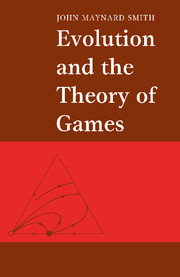Book contents
- Frontmatter
- Contents
- Preface
- 1 Introduction
- 2 The basic model
- 3 The war of attrition
- 4 Games with genetic models
- 5 Learning the ESS
- 6 Mixed strategies – I. A classification of mechanisms
- 7 Mixed strategies – II. Examples
- 8 Asymmetric games – I. Ownership
- 9 Asymmetric games – II. A classification, and some illustrative examples
- 10 Asymmetric games – III. Sex and generation games
- 11 Life history strategies and the size game
- 12 Honesty, bargaining and commitment
- 13 The evolution of cooperation
- 14 Postscript
- Appendixes
- Explanation of main terms
- References
- Subject index
- Author index
2 - The basic model
Published online by Cambridge University Press: 05 June 2012
- Frontmatter
- Contents
- Preface
- 1 Introduction
- 2 The basic model
- 3 The war of attrition
- 4 Games with genetic models
- 5 Learning the ESS
- 6 Mixed strategies – I. A classification of mechanisms
- 7 Mixed strategies – II. Examples
- 8 Asymmetric games – I. Ownership
- 9 Asymmetric games – II. A classification, and some illustrative examples
- 10 Asymmetric games – III. Sex and generation games
- 11 Life history strategies and the size game
- 12 Honesty, bargaining and commitment
- 13 The evolution of cooperation
- 14 Postscript
- Appendixes
- Explanation of main terms
- References
- Subject index
- Author index
Summary
This chapter aims to make dear the assumptions lying behind evolutionary game theory. I will be surprised if it is fully successful. When I first wrote on the applications of game theory to evolution (Maynard Smith & Price, 1973), I was unaware of many of the assumptions being made and of many of the distinctions between different kinds of games which ought to be drawn. No doubt many confusions and obscurities remain, but at least they are fewer than they were.
In this chapter, I introduce the concept of an ‘evolutionarily stable strategy’, or ESS. A ‘strategy’ is a behavioural phenotype; i.e. it is a specification of what an individual will do in any situation in which it may find itself. An ESS is a strategy such that, if all the members of a population adopt it, then no mutant strategy could invade the population under the influence of natural selection. The concept is couched in terms of a ‘strategy’ because it arose in the context of animal behaviour. The idea, however, can be applied equally well to any kind of phenotypic variation, and the word strategy could be replaced by the word phenotype; for example, a strategy could be the growth form of a plant, or the age at first reproduction, or the relative numbers of sons and daughters produced by a parent.
- Type
- Chapter
- Information
- Evolution and the Theory of Games , pp. 10 - 27Publisher: Cambridge University PressPrint publication year: 1982
- 1
- Cited by



